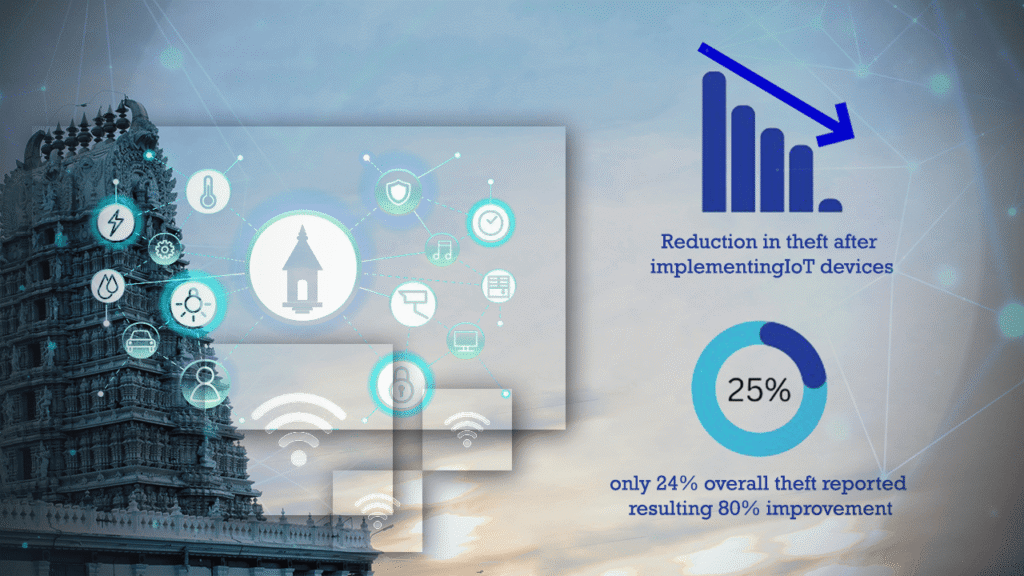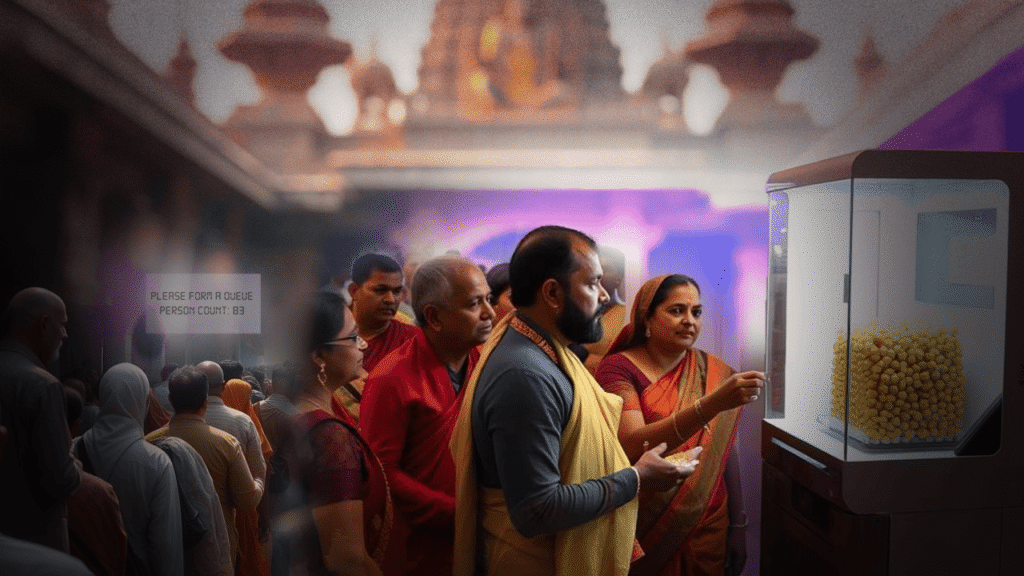Advertisement

- Updated on May 15, 2025
- IST 7:30 am

Introduction: When Tradition Meets Technology
Imagine standing in the serene courtyard of a centuries-old temple, the air thick with the scent of incense and the sound of bells echoing in the background. Devotees line up, their hands clasped in prayer, ready to offer their donations to the deity. But as you approach the donation box, something catches your eye—a sleek, modern device attached to the traditional hundi. A small screen flashes a message: “Your donation is secure. Thank you for your generosity.” This isn’t a scene from a futuristic movie; it’s happening right now in temples across India. Welcome to the age where God’s money is guarded by tech.
For generations, temples have been the heart of Indian culture, not just as places of worship but as custodians of immense wealth—wealth that, unfortunately, has often been a target for theft. In 2023 alone, temple thefts amounted to a staggering ₹500 crore, a figure that sent shockwaves through the nation. But today, in 2025, that narrative is changing. Thanks to the Internet of Things (IoT), RFID-enabled donation boxes, and AI-powered cameras, India’s temple treasures are safer than ever. So, how did we get here? And what does this mean for the future of our sacred spaces? Let’s explore.
The Temple Theft Crisis: A ₹500 Crore Wake-Up Call
Temples in India aren’t just spiritual hubs; they’re also repositories of wealth. From gold ornaments to cash donations, the offerings made by devotees can be worth millions. But with great wealth comes great risk. For years, temples have been plagued by theft—sometimes by outsiders, sometimes by insiders. In 2023, the situation hit a tipping point when a series of high-profile thefts, including one at the famous Tirupati Balaji temple, led to a loss of ₹500 crore. The nation was outraged. How could such sacred places be so vulnerable?
The problem wasn’t just about money; it was about trust. Devotees felt betrayed, and temple authorities were under fire. Traditional security measures—guards, locks, and CCTV—weren’t enough. Thieves were getting smarter, and the old ways couldn’t keep up. That’s when a quiet revolution began, spearheaded by a group of tech innovators who saw an opportunity to blend tradition with technology. Their solution? IoT-powered smart donation boxes and AI surveillance systems. And it’s working.

IoT to the Rescue: How Smart Tech is Safeguarding Donations
So, what exactly is IoT, and how is it saving India’s temple treasures? IoT, or the Internet of Things, refers to a network of connected devices that can communicate and share data in real time. In the context of temples, this means donation boxes that aren’t just passive containers but active participants in security. Here’s how it works:
- RFID-Enabled Donation Boxes: Each donation box is fitted with Radio Frequency Identification (RFID) tags. These tags allow the box to be tracked and monitored remotely. When a donation is made, the box records the amount and sends an alert if it’s tampered with. Think of it as a digital watchdog that never sleeps.
- AI-Powered Cameras: These aren’t your average CCTVs. AI cameras can detect unusual behavior, like someone lingering too long near a donation box or attempting to pry it open. They can even recognize faces and cross-reference them with a database of known offenders. If something’s amiss, the system alerts temple authorities instantly.
Take the Shri Swaminarayan Mandir in Mumbai, for example. After installing IoT donation boxes in 2024, the temple reported a 90% drop in theft attempts. “It’s like having a thousand eyes watching over us,” says Pandit Gopal, the temple’s head priest. “The technology doesn’t just protect our funds; it protects our faith.”

The Tech Behind the Magic: RFID and AI Explained
Let’s break it down for the non-techies. RFID is like a high-tech barcode. Each donation box has a tiny chip that emits a unique signal. This signal can be picked up by readers placed around the temple, allowing authorities to know exactly where each box is and if it’s been moved. If someone tries to steal the box, an alarm goes off, and the temple’s security team is notified instantly.
AI cameras, on the other hand, are like super-smart detectives. They don’t just record footage; they analyze it. Using machine learning, these cameras can spot patterns that humans might miss—like a person who keeps circling the donation area or someone wearing a disguise. In 2024, an AI camera at the Meenakshi Temple in Madurai caught a thief in the act, leading to his arrest within minutes. “It was like the camera knew what he was thinking,” recalls a temple guard.
But it’s not just about catching thieves. These technologies also make donation management more transparent. Every rupee dropped into the box is accounted for, and the data is stored securely in the cloud. This means temple authorities can track donations in real time, ensuring that every paisa goes where it’s supposed to.
A Game-Changer for Temple Security: The Numbers Don’t Lie
The impact of IoT in temples has been nothing short of revolutionary. In just two years, the adoption of smart donation boxes and AI cameras has curbed temple thefts by an estimated 85%, saving over ₹500 crore in potential losses. But the benefits go beyond just security:
- Increased Donations: When devotees know their offerings are safe, they’re more likely to give generously. Temples like the Golden Temple in Amritsar have seen a 20% rise in donations since implementing IoT systems.
- Reduced Operational Costs: With automated monitoring, temples can cut down on the number of security personnel needed, saving lakhs annually.
- Enhanced Trust: Transparency in donation management has restored faith among devotees. “I used to worry where my money was going,” says Ravi, a regular at the Siddhivinayak Temple. “Now, I know it’s in safe hands.”
The success of these technologies hasn’t gone unnoticed. In 2025, the Indian government launched the “Smart Temple Initiative,” aiming to equip 10,000 temples with IoT systems by 2030. It’s a bold move, but one that’s necessary to protect our cultural heritage.

But Is Tech Taking Away the Soul of Temples?
Not everyone is thrilled about this tech takeover. Some argue that temples are sacred spaces, and introducing gadgets like RFID tags and AI cameras disrupts the spiritual vibe. “A temple should be a place of peace, not a high-tech fortress,” says Anjali, a devotee from Kerala. Others worry about privacy—after all, AI cameras are watching your every move.
These concerns aren’t unfounded. In 2024, a controversy erupted when a temple in Tamil Nadu was accused of using AI cameras to profile devotees based on their donation amounts. The backlash was swift, and the temple had to roll back some features. It’s a reminder that while technology can solve problems, it can also create new ones if not handled carefully.
Temple authorities are aware of these sensitivities. “We’re not trying to turn temples into airports,” says Sanjay Patel, a tech consultant for the Smart Temple Initiative. “The goal is to enhance security without compromising the sanctity of the space. The tech is subtle, almost invisible.”
The Future: IoT Beyond Donation Boxes
The success of IoT in securing donations is just the beginning. Temples are now exploring other ways to use technology to enhance the devotee experience. For instance:
- Smart Queue Management: Using IoT sensors to monitor crowd density and reduce waiting times during festivals.
- Virtual Darshan: Allowing devotees to experience temple rituals online, especially during peak seasons or for those who can’t travel.
- Energy Efficiency: IoT-enabled lighting and cooling systems that adjust based on the number of people present, saving energy and costs.
In 2025, the Tirupati Balaji temple piloted a “Smart Prasad” system, where devotees receive their offerings via automated dispensers, reducing waste and ensuring hygiene. It’s a small step, but it shows how IoT can touch every aspect of temple life.

Conclusion: A New Era for India’s Temples
The marriage of IoT and Indian temples isn’t just about preventing theft; it’s about preserving trust, enhancing transparency, and ensuring that our sacred spaces remain sacred. Yes, there are challenges—balancing tradition with technology isn’t easy. But as we’ve seen, when done right, tech can be a temple’s best friend.
So, next time you drop a coin into a donation box, take a moment to appreciate the silent guardians watching over it. God’s money is now guarded by tech, and that’s a blessing we can all be thankful for.
You May Like This
Advertisement

You May Like This








Advertisement

Advertisement

Advertisement





